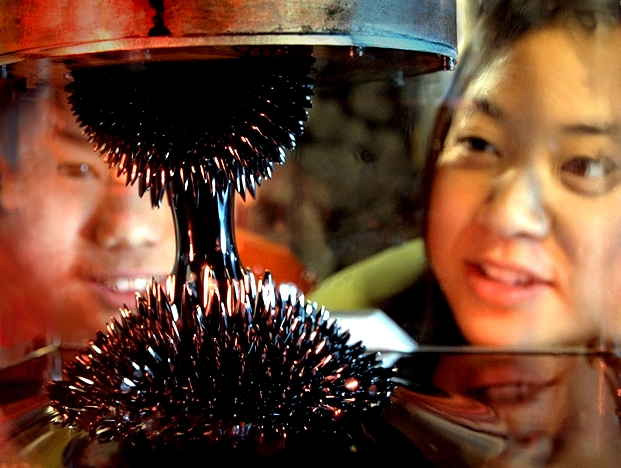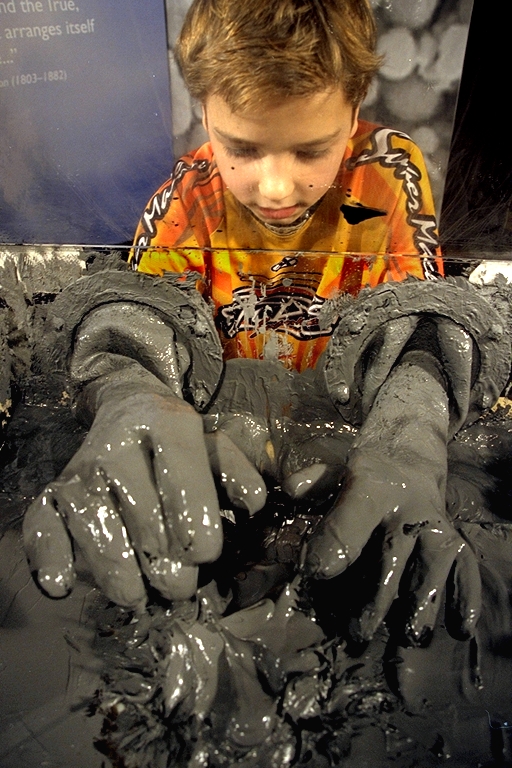Strange Matter

Where Button Pushers Go To Learn About "stuff”
By Sarah Benton
"Welcome to smash the glass crank up the ball and let it go.” The scrolling digital sign read. A brother and sister decided to take the challenge. The boy began cranking as fast as he possibly could, egged on by the scrolling sign: "crank it higher.”
"I want to push the button!” his sister insisted. He gave in and as she pushed it the sign read, "releasing.” The girl covered her ears and with a loud thunk the ball hit the glass, once again leaving it intact. As their mom turned to move on to the next part of the exhibit, the boy exclaimed, "I want to push the button this time!”
This scene was not uncommon as I entered Strange Matter the latest featured exhibit at the Pacific Science Center. I was instantly transported into a world of stimulation and chaos as I stepped into the room. The exhibit was made up of several kiosks consisting of hands-on stations and verbose interpretive signs in muted lime green and orange. I didn't take the time to count, but apparently there were over 40 hands-on interactives. I'm not surprised. There were people pushing buttons and pulling cranks everywhere.
"Strange Matter” is a traveling exhibit examining materials science, or in other words, the "science of stuff.” From an educational standpoint, this has the potential for being a very engaging topic especially in a consumer culture where we are surrounded by an ever changing onslaught of products. The Ontario Science Centre keyed into this interest in the secrets behind everyday things when developing Strange Matter.
One of the most popular spots in the exhibit hall was "Smash the Glass.” Here a box holds a 16 pound bowling ball on an arm that can be cranked up high by the museum visitor and then with the push of a button released to slam into a sheet of tempered glass. The title "Can you smash the glass?” taunts the destructive young child in each of us. A counter at the top of the box informed visitors that the glass has been bashed 424,844 times since the last time it shattered. The evidence of the last shattering littered the floor of the box. Visitors like the brother and sister I observed lined up to crank up the ball and push the release button.
One of the parts of this exhibit that I had a love/hate relationship with were the wordy signs. As someone who has experience designing exhibits for science museums and nature centers, I can attest to the constant struggle in determining how much is too much when it comes to sign wording. Often your purpose is to have your visitors learn something new, which means your signs need to be succinct and engaging enough for them to read. The exhibit designers did a great job of providing a broad range of information and giving recognizable examples for a general audience. Despite this they were quite wordy and some visitors, like me, might find them difficult to read in their entirety.
 |  |
"Smash the Glass” is one stop in the exhibit hall that has very little wording and explanatory interpretive signage. There is no question what is going on here. Just as people might stand around a slot machine waiting their turn to try to set off the alarms and flashing lights, visitors would stand, observe, and hope that they would be the one that would win the prize of causing the glass to shatter into thousands of pieces. It did not seem that many were stopping to ponder why the glass was stronger. Those who are curious about the science behind the glass would have to investigate further.
Although the fun factor with "Smash the Glass” is high, you have to look closer to find out why this glass withstands the constant smashing. The glass is tempered, meaning it has been strengthened by heating and rapid cooling. There is a video that you can play nearby that shows some slow motion footage of regular glass versus tempered glass when it is smashed, and a flip door on the box itself that explains that tempered glass is five times the strength of your average glass. The scrolling digital sign doesn't taunt you to open and read the flip door interpretation. It just begs you to push the button. In order to learn more you are given the choice to do so yourself.
Strange Matter is certainly visually appealing and hands-on. One section of the exhibit focuses on ferrofluids, liquids that contain small particles of iron, making them magnetic. These ferrofluids are used in a variety of items many of us use on a regular basis, including cd players, dvd players, and x-ray machines. They may even have possibilities for medical uses in cancer treatment.
Visitors are drawn into one installment of the ferrofluids section with a sign that says, "Want to feel something really weird?” At this stop you stick your hands into long rubber gloves that are affixed to the inside of a box. Inside there is a slippery mud-like substance. There are some instructions on how you should push a button with your elbow once you have your hands in the gloves and then the aforementioned "really weird” thing will happen. I'm not sure if this part of the exhibit was not functioning the particular day of my visit, but, nothing happened when I pushed the button. Although it didn't work just sticking my hands in the gloves made me feel important. It was like I was about to complete some very delicate task that could not risk contamination or perform a surgical procedure on a patient living in a bubble. The children visiting the exhibit seemed to be having a grand time sticking their arms into the gloves too.
The next ferrofluid interactive was functioning and it was fascinating. There was a pool of oily fluid that you could move a magnet underneath. By moving the magnet around I created alien-like spikes from the ferrofluid. The magnetic forces created blobs and bulges that were oddly life like. When the magnet dropped down away from the fluid the shapes rising up out of the liquid disappeared back into the pool. It was engaging and completely mesmerizing.
One of the advertised highlights of the exhibit is Aerogel, a foam solid that is made from silica and 99 percent air making it one of the lightest solids in the world. For all the hype, seeing the Aerogel in a case was a bit anticlimactic, it's something that I would love to hold myself to experience. However, also in the foam section of the exhibit there were museum interpreters breaking soapy foam bubbles from a column that was slowly growing in the middle of the exhibit hall. This satisfied the hands-on needs of myself and other visitors.
Another material that was very popular with museum goers was nitinol, a memory metal that can be reshaped and then return to its original shape by adding heat. One hands-on kiosk exhibiting this material posed the question: Can you hot-wire a hole-in-one? The task was to drop a ball into a hole by maneuvering mechanical arms made of nitinol. To move these arms there were hot and cold levers which would make the heat sensitive metal bend or straighten in addition to the obligatory button to press. It was a challenging task, something between surgery and those machines at the arcade where you maneuver a claw around to grab a stuffed animal that inevitably drops back into the pile once you get close to claiming your prize.
 |  |
A young girl was clearly very focused on trying to get her hole-in-one while her caregiver was dutifully reading verbatim the lengthy interpretive sign that accompanied the station. I admired this woman's attempt at explaining the exhibit to the child, as I saw very little interaction between adults, children and exhibits that day. Most of Strange Matter's interactives were serving as hands-on babysitters. The girl working the nitinol hole-in-one was still focused and the science teacher in me hoped that this child would come away having learned some science content in addition to having a good time. Her caregiver reached the end of the sign. There was a moment of silence. "But what does the button do?” the girl asked.
No doubt the children who visit this exhibit learn quite a bit just from manipulating the materials and completing the hands-on tasks. The opportunities for learning about materials science are not limited to the main exhibit hall at the Pacific Science Center. Many of the interpretive signs direct you to the www.strangematterexhibit.com website, another spot teeming with information and many different activities for children in addition to a teacher's guide and family guide with activities to do at school and home. In terms of educational websites, it was quite good, and it is obvious that the "Strange Matter” project is much more extensive than simply a traveling museum exhibit.
Visitors to Strange Matter should take into consideration that there is a lot of information to be digested here. Expect that some parts of the exhibit will not be manipulative, such as the Aerogel. Portions of the exhibit are weary from use like the ferrofluids box. Since there are many stations where only one or two people can manipulate the equipment at a time it is to be expected that during busy times at the science center you will spend some time waiting your turn. For those headed to the Pacific Science Center for an educational experience or a play outing the exhibit provides plenty of excitement for young hands and minds in addition to learning opportunities.
Overall I enjoyed myself at "Strange Matter.” Any exhibit for a general audience has a variety of purposes and everyone comes away with something different from it. This exhibit has something for everyone, hands-on interactives with lots of buttons and levers for the younger kids, thorough interpretation for an older audience and even some humor for those who are paying close enough attention. For example the one-liner from comedian Steven Wright I found on the "Foam and You, What is so fascinating about foam?” interpretive sign: "Sponges grow in the ocean . . . I wonder how much deeper the ocean would be if that didn't happen.” Definitely something I pondered long after leaving.
Children will especially enjoy this exhibit regardless of whether or not they come away understanding the importance of a silicon ingot (one of the basic building blocks of a microchip). If all else fails at least they will be busy trying to push somebody else's buttons for a while!
Sarah Benton is an environmental educator and graduate student at the University of Washington in Science Education.
Images:
Top: At "Smash the Glass” children try to be the first to break a sheet of tempered glass by cranking up a bowling ball on a lever and releasing it to bash the target. Photo: Richard Souza, Materials Research Society
Middle: In the ferrofluids section of Strange Matter you can manipulate a magnet that makes this magnetic fluid jump and spike. Ferrofluids are liquids with tiny iron particles suspended within them. They are used in many household items such as cd and dvd players. Photo: Materials Research Society
Bottom: This boy investigates magnetic fluids, where what seems like a substance with the consistency of wet mud can quickly be changed to a solid by activating a magnet. Photo: Materials Research Society

|